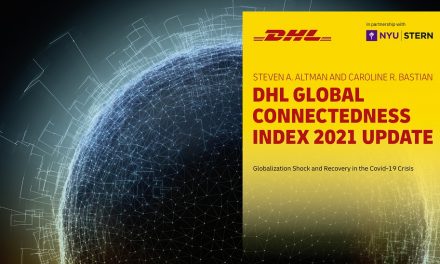
DHL Report “clearly debunks the perception of globalization going into reverse gear”

DHL and New York University’s Stern School of Business have published the new DHL Global Connectedness Index 2022, an in-depth report on the state of globalization and its prospects. Analyzing data from 171 countries and territories, it reveals how flows of trade, people, capital, and information move around the world.
The report shows that international flows have been remarkably resilient in the face of recent shocks such as the Covid-19 pandemic and the war in Ukraine. After a slight decline in 2020, the composite DHL Global Connectedness Index rose back to above pre-pandemic levels in 2021. The currently available data points to a further increase in 2022, despite slower growth in some flows. International trade in goods was 10 percent above pre-pandemic levels in mid-2022. International travel remained 37 percent below 2019 levels in 2022, but doubled compared to 2021.
“The latest DHL Global Connectedness Index data clearly debunks the perception of globalization going into reverse gear,” John Pearson, CEO of DHL Express, concludes. “Globalization is not just a buzzword, it’s a powerful force that has transformed our world for the better. By breaking down barriers, opening up markets and creating opportunities, it has enabled individuals, businesses and entire nations to flourish and thrive like never before. As we continue to embrace globalization, we can build a brighter future that benefits us all, creating a world that is more interconnected, more prosperous and more peaceful than ever before.”
U.S. and China: Geopolitical rivalry frays connection
The DHL Global Connectedness Index provides evidence that the U.S. and China are decoupling in many fields. Looking at 11 types of trade, capital, information, and people flows (such as merchandise exports, M&A transactions, and scientific research collaboration), the share of U.S. flows with China declined for 8 out of 11 types since 2016. In the same period, the share of China’s flows with the U.S. decreased for 7 out of 10 types with data available for China. Several of these were large declines. Nonetheless, the U.S. and China are still linked by far greater flows than any other two countries that do not share a border. Further, the data shows that, so far, the decoupling between these two countries has not led to a broader fragmentation of global flows between rival blocs of countries.
No evidence of trend towards regionalization – average distance of international flows increased
Analyses in the DHL Global Connectedness Index also show that predictions of a shift from globalization to regionalization have not – at least yet – come to fruition. The average distance traversed by trade, capital, information, and people flows has increased over the past two decades, and trade flows even stretched out over longer distances during the Covid-19 pandemic. The only category that displays a clear recent shift toward regionalization is people flows. This is due to the dramatic change in travel patterns during the Covid-19 pandemic.
“It remains an open question whether trade patterns will become significantly more regionalized in the future,” says Steven Altman, Senior Research Scholar and Director of the DHL Initiative on Globalization at NYU Stern’s Center for the Future of Management. “Many companies and governments are focused on nearshoring to regionalize supply chains, and there are substantial business benefits that can come from regionalization. On the other hand, more than half of all trade already happens within regions, and the benefits of long-distance trade are still important, especially as inflation remains high, economic growth has slowed, and container shipping rates have come back down.”
Ranking of most globally connected countries: Netherlands at the top
In the country ranking of the DHL Global Connectedness Index 2022, the Netherlands was again the most globally connected country. Singapore ranked second overall and first in terms of the size of international relative to domestic flows. The UK has the most globally distributed flows. Among the 55 most globally connected countries, there are representatives from every world region.
The DHL Global Connectedness Index
Published regularly since 2011, the renowned DHL Global Connectedness Index provides reliable findings on globalization trends by analyzing 13 types of international trade, people, capital, and information flows. The 2022 edition is based on over four million data points from 171 countries, accounting for 99.7 percent of the world’s gross domestic product and 96 percent of its population. A collection of 171 one-page country profiles provides concise summaries of individual countries’ globalization patterns.
The report was commissioned by DHL and authored by Steven A. Altman and Caroline R. Bastian of New York University Stern School of Business.







